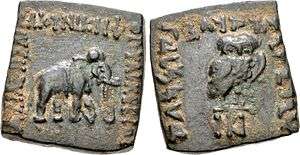Archebius
Archebius Dikaios Nikephoros (Greek: Ἀρχέβιος ὁ Δίκαιος, ὁ Νικηφόρος; epithets mean respectively, "the Just", "the Victorious"; formerly read as "Archelius"[1][2]) was an Indo-Greek king who ruled in the area of Taxila. Osmund Bopearachchi dates him to c. 90–80 BCE, and R. C. Senior to about the same period. He was probably one of the last Indo-Greek kings before the Saka king Maues conquered Taxila, and a contemporary of Hermaeus in the west. He may have been a relative of Heliokles II, who used a similar reverse and also the title Dikaios.
| Archebius Dikaios Nikephoros ("The Just and Victorious") | |
|---|---|
 Portrait of Archebios on one of his tetradrachms | |
| Indo-Greek king | |
| Reign | 90–80 BCE |

Obv: Helmetted king Archebius. Greek legend: ΒΑΣΙΛΕΩΣ ΔΙΚΑΙΟΥ ΝΙΚΗΦΟΡΟΥ ΑΡΧΕΒΙΟΥ "Of King Archebius the Just and Victorious"
Rev: Zeus, with Kharoshthi legend: MAHARAJASA DHRAMIKASA JAYADHARASA ARKHEBIYASA "Archebios, the victorious king of the Dharma.

Obv: Bareheaded king Archebius. With Greek legend: ΒΑΣΙΛΕΩΣ ΔΙΚΑΙΟΥ ΝΙΚΗΦΟΡΟΥ ΑΡΧΕΒΙΟΥ "Of King Archebius the Just and Victorious"
Rev: Zeus, with Kharoshthi legend: MAHARAJASA DHRAMIKASA JAYADHARASA ARKHEBIYASA "Archebios, the victorious king of the Dharma.

Obv: Helmetted king Archebius holding a spear. With Greek legend: ΒΑΣΙΛΕΩΣ ΔΙΚΑΙΟΥ ΝΙΚΗΦΟΡΟΥ ΑΡΧΕΒΙΟΥ "Of King Archebius the Just and Victorious"
Rev: Zeus, with Kharoshthi legend: MAHARAJASA DHRAMIKASA JAYADHARASA ARKHEBIYASA "Archebios, the victorious king of the Dharma.

Coin types
Archebius issued silver with diademed or helmeted king, sometimes in spear-throwing pose. On the reverse is Zeus standing facing, holding a thunderbolt or on some issues an aegis.
Archebius also struck a rare series of Attic tetradrachms, found in Bactria.
He issued bronzes with an owl / Nike.
Overstrikes
Archebius overstruck two coins of Peukolaos.
 King thrusting javelin.
King thrusting javelin. Bust of Zeus, and caps of the Dioscuri with palms.
Bust of Zeus, and caps of the Dioscuri with palms.
References
- "In the Masson collection of 1836 were found Archebius ( read at the time as 'Archelius')" in Imam, Abu (1966). Sir Alexander Cunningham and the Beginnings of Indian Archaeology. Asiatic Society of Pakistan. p. 134.
- Prinsep, James. Journal of the Asiatic Society of Bengal Vol V 1836. pp. 548–549.
- O. Bopearachchi, "Monnaies gréco-bactriennes et indo-grecques, Catalogue raisonné", Bibliothèque Nationale, Paris, 1991, p.453
- Quintanilla, Sonya Rhie (2 April 2019). "History of Early Stone Sculpture at Mathura: Ca. 150 BCE - 100 CE". BRILL – via Google Books.
- The Shape of Ancient Thought. Comparative studies in Greek and Indian Philosophies by Thomas McEvilley (Allworth Press and the School of Visual Arts, 2002) ISBN 1-58115-203-5
- Buddhism in Central Asia by B. N. Puri (Motilal Banarsidass Pub, January 1, 2000) ISBN 81-208-0372-8
- The Greeks in Bactria and India by W. W. Tarn, Cambridge University Press.
External links
| Preceded by Menander II as ruler in Arachosia and Gandhara |
Indo-Greek ruler in Arachosia, Gandhara and Punjab 90–80 BCE |
Succeeded by Maues as Indo-Scythian king |
| Preceded by Artemidoros as ruler in Punjab |